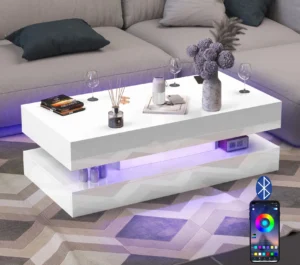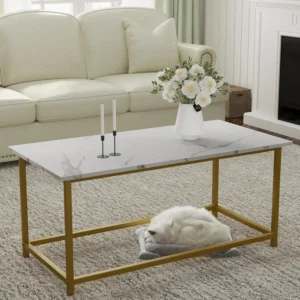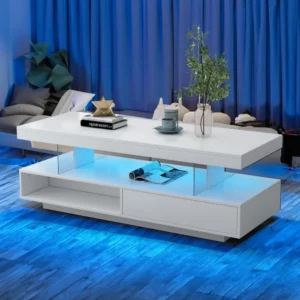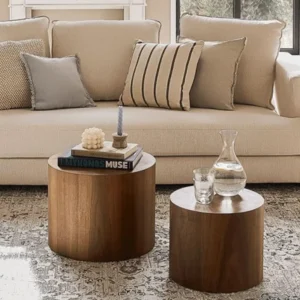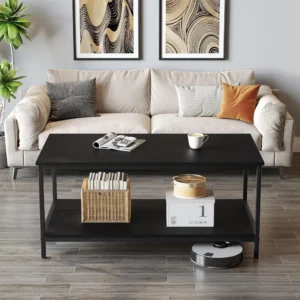Introduction: The Timeless Elegance of Marble in Modern Living Spaces
From ancient Roman palaces to contemporary living rooms, marble has remained a symbol of luxury and timeless beauty. As a natural stone formed over millennia, marble brings a sense of history and permanence into our everyday spaces. When incorporated into coffee tables, this remarkable material transforms an ordinary piece of furniture into a captivating focal point that commands attention.
What makes marble so visually stunning is its unique character – the mesmerizing veining patterns that tell the story of the earth’s natural processes, the subtle luminosity that catches light in unexpected ways, and the cool, smooth texture that invites touch. Each marble coffee table represents nature’s artistry captured in functional form.
In the following sections, we’ll explore the visual elements that make marble coffee tables so appealing, their remarkable versatility across design styles (particularly within mid-century modern aesthetics), and the undeniable luxury they bring to living spaces. Whether you’re considering adding a marble piece to your home or simply appreciating its beauty, understanding the design guide for marble surface coffee tables provides valuable insights into this enduring material’s allure.
The Visual Language of Marble: Nature’s Artistic Expression
What makes marble truly extraordinary is the story of its creation – a narrative written in stone through natural processes spanning millions of years. This geological journey results in visual properties that no artificial material can fully replicate.
The veining patterns in marble create a natural artwork that adds movement and visual interest to any space. Some marbles feature delicate linear veins that sweep across the surface like brush strokes, while others display dramatic, bold patterns that resemble abstract paintings. Brecciated marbles showcase angular fragments cemented together in captivating collages, and web-like patterns create intricate networks across the surface that draw the eye and invite contemplation.
Perhaps most remarkable is that no two marble slabs are identical. Even pieces cut from the same quarry block will display unique variations, ensuring your coffee table is truly one-of-a-kind. This natural uniqueness stands in stark contrast to mass-produced furniture, offering a sense of exclusivity and connection to the natural world.
Beyond pattern, marble possesses a subtle luminosity that seems to emanate from within. This quality allows marble surfaces to reflect light in a soft, diffused manner that brings a gentle glow to interiors. The way light interacts with marble creates a visual depth that flat, manufactured materials simply cannot achieve.
For those interested in exploring specific varieties, our ultimate guide to marble types for coffee tables provides comprehensive information on the distinctive characteristics of various marble options.
Marble’s Color Palette: From Classic Whites to Bold Statements
The color range available in marble coffee tables offers something for every interior style and personal preference, from subtle neutrals to dramatic statements.
Classic Whites
White marbles like Carrara and Calacatta remain perennially popular for good reason. With their bright, clean appearance and delicate gray veining, these varieties bring lightness and visual expansion to spaces. White marble coffee tables serve as versatile centerpieces that complement virtually any color scheme. Calacatta typically features bolder, more dramatic veining against a whiter background, while Carrara offers a softer gray background with more subtle patterns.
Dramatic Darks
For those seeking sophistication and contrast, dark marbles like Nero Marquina and Emperador make powerful statements. Nero Marquina’s deep black background with crisp white veining creates striking visual tension, while Emperador’s rich brown tones with lighter veining add warmth and depth. These darker varieties particularly shine in contemporary settings or spaces with lighter furnishings where they anchor the design with visual weight.
Warm Tones
Warm-toned marbles like Crema Marfil and travertine-inspired varieties offer a comforting middle ground. Their soft beige, honey, and amber hues bring natural warmth that feels inviting and timeless. These marbles connect beautifully with wood elements and earth-toned textiles, creating cohesive, harmonious interiors that feel grounded and serene.
Unique Colors
For the bold at heart, specialty marbles in green, rose, and blue tones make unforgettable focal points. Green Guatemala marble with its forest-like patterns or rose marble with pink and burgundy tones can serve as artistic centerpieces that inspire entire room designs. These distinctive options allow for personal expression while maintaining the inherent luxury of natural stone.
The choice of color dramatically impacts how a space feels – white marbles create airy brightness, dark varieties add drama, and colored options can complement or contrast with existing decor elements. When selecting your perfect finish, choosing the perfect marble finish for your coffee table depends greatly on the marble’s natural coloration and your desired effect.
Surface Aesthetics: How Finishes Transform Marble’s Appearance
The finish applied to a marble coffee table significantly transforms both its visual impact and tactile experience. This often-overlooked element can completely alter how we perceive the same piece of stone.
A polished finish creates a glossy, mirror-like surface that maximizes marble’s reflective properties. This high-shine treatment enhances color saturation, making veining patterns appear more dramatic and colors more vivid. Polished marble exudes formal elegance and luxury, creating a sophisticated focal point that captures and plays with light. However, this finish also highlights every fingerprint and water mark, making maintenance more visible.
In contrast, a honed or matte finish offers subtle sophistication with a smooth but non-reflective surface. This treatment softens marble’s appearance while minimizing glare, creating a more contemporary, relaxed aesthetic. The colors appear slightly muted but with a depth that many designers prefer for modern interiors. Honed finishes also help disguise minor scratches and etching that occur with normal use.
For those seeking textural interest, leathered or brushed finishes provide a tactile quality with slight surface variations. These treatments preserve the natural color while adding a rustic, organic feel that invites touch. The subtle texture helps hide imperfections and fingerprints, making these finishes practical for everyday use while still honoring the stone’s natural beauty.
Each finish changes how light interacts with the table – polished finishes create reflections and sparkle, while honed surfaces diffuse light more evenly throughout a space. These finish choices significantly influence how the design elements of marble mid-century tables are perceived within a room’s overall atmosphere.
Marble and Design Harmony: Complementing Different Interior Styles
One of marble’s most remarkable qualities is its chameleon-like ability to enhance virtually any interior design style, from ultramodern to traditionally classic.
In modern and minimalist settings, marble coffee tables with clean lines and simple geometric forms create sophisticated focal points. Light marbles with subtle veining complement the restrained aesthetic while adding natural texture to otherwise austere spaces. The organic patterns provide visual interest without overwhelming the intentional simplicity of minimalist design.
Marble particularly shines within mid-century modern environments, where its natural elegance balances beautifully against warm woods and organic forms. The juxtaposition of marble’s cool surface with the warm tones of teak or walnut creates a harmonious tension that epitomizes sophisticated mid-century design. Slender, tapered legs in brass or wood supporting a marble top perfectly capture this iconic aesthetic that continues to influence contemporary design.
In classic and traditional interiors, marble coffee tables often feature more ornate edges, richer marbles like Emperador or Rosso Levanto, and carved wooden bases. These elements complement traditional furnishings while adding a touch of timeless luxury that reinforces the established elegance of these spaces.
For Scandinavian-inspired rooms, light marbles with minimal veining maintain the bright, airy feel central to Nordic design. When paired with pale woods and natural textiles, these marble tables enhance the serene simplicity characteristic of this style while adding subtle visual texture.
Industrial spaces benefit from the unexpected refinement marble brings to otherwise utilitarian environments. The contrast between raw materials like exposed brick or steel and the polished sophistication of marble creates compelling visual stories that elevate industrial design beyond mere functionality.
For more specific guidance on this perfect pairing, our collection of mid-century marble coffee tables showcases how this material enhances the clean lines and organic forms typical of this enduring design movement.

The Art of Proportion: Selecting the Perfect Size and Shape
The size, height, and shape of a marble coffee table significantly influence its aesthetic impact within a space. Getting these proportions right creates visual harmony that makes the entire room feel thoughtfully designed.
For proper proportion, a coffee table should generally measure about two-thirds the length of your sofa and stand at a height equal to or slightly lower than your sofa’s seat cushions (typically 16-18 inches). This relationship creates visual balance while ensuring practical functionality. A table that’s too small appears insignificant, while one that’s too large overwhelms the surrounding furniture and impedes comfortable movement.
Shape choice dramatically affects how people interact with both the table and the surrounding space. Round and oval marble tables create natural flow with their absence of corners, making them ideal for smaller rooms or spaces with high traffic. Their continuous curve encourages conversation by allowing everyone equal access to the surface and softens rooms dominated by rectangular elements like sofas and rugs.
Rectangular and square tables offer maximum surface area and align neatly with the typical shape of sofas. Their defined edges provide structure and organization to larger seating arrangements. A rectangular marble table parallel to a sectional creates a cohesive look that guides furniture placement throughout the room.
For those seeking artistic expression, asymmetrical or organic shapes transform coffee tables into sculptural elements. These free-form designs make bold statements while often providing unexpected functionality through varied surface levels or integrated elements.
When considering marble specifically, the visual weight of the material should influence your size choice. The substantial nature of marble means a large table might dominate a delicate space, while a small marble piece might appear too heavy if not balanced with other substantial elements.
Exploring the aesthetic features of round mid-century tables can provide additional insights into how shape influences overall visual appeal in your space.
Base Design: The Foundation of Coffee Table Aesthetics
While the marble top often captures immediate attention, the base design profoundly impacts the overall aesthetic and style statement of a coffee table. This foundational element determines whether the piece reads as modern, traditional, or somewhere in between.
Metal bases offer numerous stylistic opportunities depending on the material and treatment. Brass bases bring warmth and luxury with their golden glow, particularly when formed into slender, tapered legs that echo mid-century design principles. Stainless steel creates a contemporary, sleek appearance that emphasizes clean lines and precision. Matte black metal bases provide dramatic contrast against light marble, creating a graphic, modern statement that works beautifully in minimalist or industrial settings.
Wooden bases introduce natural warmth that softens marble’s coolness. Light woods like ash or oak create airy, Scandinavian-inspired pieces, while rich walnut or mahogany bases complement the luxury of marble with their deep tones and fine grain patterns. The combination of wood and stone creates a dialogue between natural materials that adds depth to interior design schemes.
Pedestal and plinth designs make powerful sculptural statements. A solid cylindrical pedestal base gives a table monolithic presence and classical references, while a geometric plinth creates a contemporary monument. These substantial bases visually anchor marble tops and often allow the stone to appear as though it’s floating, showcasing its beauty from all angles.
Minimalist “floating” designs with nearly invisible or remarkably slender supports create the illusion that the marble is hovering in space. This approach makes the stone the undisputed focal point while adding a sense of lightness that counterbalances marble’s natural weight.
The ratio between base and top significantly influences a table’s visual character. A substantial base with a thin marble top creates top-heavy tension, while a delicate base supporting a thick marble slab suggests a pleasing defiance of gravity.
Explore our collection of mid-century modern marble top coffee tables to see how various base designs complement different marble tops to create cohesive, beautiful pieces.
Styling Your Marble Centerpiece: Curating a Balanced Display
A marble coffee table provides the perfect canvas for thoughtful styling that enhances both the stone’s natural beauty and your overall interior design. The key lies in creating balanced arrangements that complement rather than compete with the marble’s inherent patterns and colors.
Creating contrast through complementary materials adds depth and visual interest to your display. Consider incorporating elements that provide textural counterpoints to marble’s smooth surface – rough ceramics, nubby textiles, or organic wooden objects create tactile diversity that enhances the sensory experience. Metal accents in brass or copper can echo veining colors within the marble while adding warm reflectivity.
Building visual interest through height variation prevents flat, uninteresting arrangements. Try grouping objects of different heights – tall candlesticks or a sculptural vase alongside lower elements like books or decorative boxes. This creates a dynamic composition that draws the eye across the table’s surface. Using the rule of three (grouping objects in odd numbers) naturally creates more interesting, asymmetrical arrangements.
When selecting colors for styling objects, look to your marble for guidance. Choose items that pick up subtle tones in the stone’s veining or background, creating a cohesive color story that feels intentional and sophisticated. For high-contrast marbles with dramatic veining, echo both the background color and the vein color in your accessories to tie everything together.
The balance between negative space and display items is crucial – avoid overcrowding your marble surface. The stone itself is a work of art worthy of breathing room. Leaving portions of the marble visible allows its natural beauty to remain a feature rather than disappearing beneath too many objects.
Consider seasonal rotations that refresh your styling throughout the year. Summer might call for lighter objects and perhaps a small vase of fresh flowers, while winter arrangements might incorporate heavier objects and warm-toned accessories that create a cozy atmosphere.
For more specific advice on styling within a particular aesthetic, our guide to styling marble coffee tables in mid-century settings offers targeted recommendations that honor both the material and this beloved design tradition.
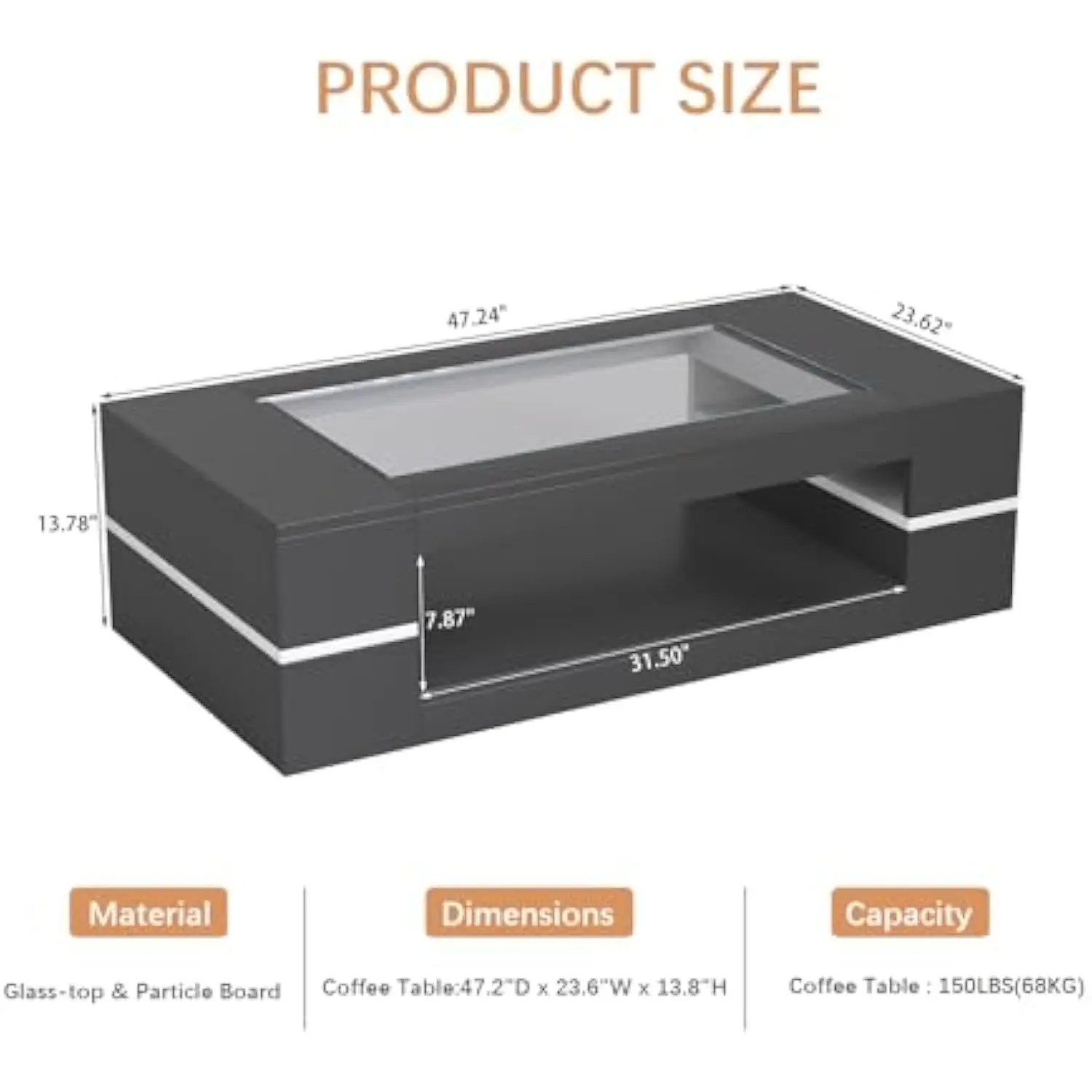
Light and Marble: Illuminating Natural Beauty
The relationship between light and marble creates a fascinating interplay that dramatically affects how we perceive this remarkable material throughout the day and evening.
Natural daylight reveals marble’s true character in its most authentic form. Morning and afternoon sunlight penetrating windows highlights the stone’s subtle translucency – a quality particularly noticeable along the edges of lighter marbles, where light appears to penetrate slightly beneath the surface. This creates a luminous glow that synthetic materials simply cannot replicate. Throughout the day, shifting sunlight angles emphasize different aspects of veining patterns, creating an ever-changing visual experience.
Ambient lighting transforms marble’s evening presence. The soft, diffuse glow from table lamps or overhead fixtures with dimmers allows marble to reflect light in gentle, flattering ways. This type of lighting enhances the overall atmosphere while letting the marble contribute to the room’s warm ambience rather than demanding attention.
Strategic accent lighting can dramatically highlight marble’s special features. A well-placed floor lamp casting light across a table’s surface emphasizes the three-dimensional quality of veining and creates subtle shadows that add depth. Picture lights or art spotlights directed at a particularly beautiful marble piece treat it as the artwork it truly is.
Light temperature significantly impacts how marble colors are perceived. Warm lighting (2700-3000K) enhances creams, golds, and red undertones in marble, creating a cozy, inviting atmosphere. Cool lighting (4000K+) accentuates whites, grays, and blue undertones, producing a crisper, more contemporary feel. Adjustable lighting systems allow you to customize the appearance based on mood or time of day.
For marble with highly polished surfaces, consider lighting placement carefully to minimize glare while maximizing the stone’s natural beauty. Diffused rather than direct lighting often works best for these reflective finishes.
Exploring how different shapes interact with lighting can help you select the perfect table – our collection of mid-century modern round coffee tables demonstrates how curved forms catch and reflect light in particularly interesting ways.
The Psychology of Luxury: Why Marble Evokes Sophistication
Marble’s association with luxury and sophistication runs deeper than mere tradition or convention. There are fascinating psychological and historical factors that explain our enduring attraction to this noble material.
Throughout history, marble has adorned the most significant architectural achievements of civilization – from the Parthenon in ancient Athens to Renaissance palaces and modern landmarks. This historical association with important buildings and monuments creates an unconscious connection to permanence, achievement, and cultural significance. When we bring marble into our homes, we subtly reference this rich heritage.
In today’s world of mass production and synthetic materials, natural stone represents something increasingly rare – an irreplaceable material formed by geological processes over millions of years. This inherent scarcity and natural origin tap into our psychological appreciation for authenticity and uniqueness. Unlike manufactured materials that can be endlessly replicated, each marble piece tells a specific geological story that cannot be duplicated.
The physical properties of marble also contribute to its perceived value. Its substantial weight provides a sense of solidity and permanence in an increasingly disposable world. The cool touch of the stone surface creates a distinctive tactile experience that signals quality and substance. These sensory experiences register subconsciously as markers of luxury.
Beyond aesthetics, marble represents a long-term investment in quality. Unlike trendy materials that quickly date a space, marble’s classic appeal transcends design fads, maintaining its value and visual appeal across decades. This timelessness makes it both a practical and psychological investment in enduring quality.
Perhaps most importantly, a single marble element like a coffee table can elevate an entire room’s perceived value. Even when surrounded by more modest furnishings, marble creates a focal point that draws attention and anchors a space with its natural elegance.
Our collection of mid-century modern rectangular coffee tables demonstrates how different table configurations contribute to this sense of sophisticated luxury in various spaces.
Mid-Century Modern Lift Top Coffee Tables, Mid-Century Modern Square Coffee Tables
$454.73 Select options This product has multiple variants. The options may be chosen on the product pageMid-Century Modern Large Coffee Tables, Mid-Century Modern Rectangular Coffee Tables
$603.26 Select options This product has multiple variants. The options may be chosen on the product pageMid-Century Modern Marble Top Coffee Tables, Mid-Century Modern Rectangular Coffee Tables, Mid-Century Modern White Coffee Tables
Price range: $163.28 through $189.22 Select options This product has multiple variants. The options may be chosen on the product pageMid-Century Modern Rectangular Coffee Tables, Mid-Century Modern White Coffee Tables
$605.68 Select options This product has multiple variants. The options may be chosen on the product pageMid-Century Modern Nesting Table Sets, Mid-Century Modern Round Coffee Tables
$462.57 Select options This product has multiple variants. The options may be chosen on the product pageMid-Century Modern Black Coffee Tables, Mid-Century Modern Rectangular Coffee Tables
$272.43 Select options This product has multiple variants. The options may be chosen on the product page
Cultivating Beauty Over Time: Living with Marble
One of marble’s most distinctive characteristics is its ability to evolve aesthetically over time, developing a patina that tells the story of its life within your home.
Many design philosophies, particularly the Japanese concept of wabi-sabi, celebrate the beauty found in natural aging and subtle imperfections. With marble, this perspective transforms what some might view as flaws into character-building elements that enhance the material’s authenticity. Small etchings from acidic drinks, slight color variations developing over years, and the subtle softening of edges all contribute to a coffee table’s unique history and lived-in elegance.
To maintain marble’s visual integrity while allowing its natural character to develop, simple care practices make a significant difference. Using coasters for drinks, wiping spills promptly, and occasionally cleaning with stone-specific products preserves the stone’s essential beauty while allowing a natural patina to develop gradually rather than through neglect. These small habits protect the marble’s fundamental character while allowing it to age gracefully.
Well-maintained marble develops a subtle glow over decades that newly fabricated stone simply cannot replicate. This visual depth comes from countless tiny interactions with its environment – the oils from hands touching its surface, the gentle polishing effect of cleaning, and the natural interaction with air and light. The result is a table that looks authentically beautiful rather than artificially perfect.
Perhaps most meaningfully, a marble coffee table that ages alongside your family becomes a physical repository of memories and experiences. The slight ring from a celebration toast or the subtle wear from years of family gatherings becomes part of its visual story, creating an emotional connection that transcends mere functionality.
For specific guidance on preserving your marble’s beauty, our guide to cleaning and maintaining marble coffee tables provides practical advice framed with aesthetic considerations in mind.
Material Dialogue: How Marble Compares to Alternative Surfaces
When considering a coffee table, understanding how marble’s aesthetic qualities compare to other popular materials helps clarify what makes this stone so distinctively beautiful.
Marble and wood represent perhaps the most classic material contrast in furniture design. While marble offers cool elegance and visual precision with its crisp edges and polished surface, wood brings organic warmth through grain patterns and a natural tactile quality. Marble makes a bold statement of refinement, while wood often creates a sense of comfort and casual sophistication. In many successful designs, these materials complement each other – the marble top providing durability and visual interest while wooden elements add warmth and approachability.
The comparison between marble and glass reveals different approaches to luxury. Marble communicates substance and permanence with its solid, weighted presence, while glass creates ethereal lightness and transparent elegance. Glass tables allow light to flow through a space uninterrupted and visually “disappear” to reduce visual weight. In contrast, marble anchors a room with definitive presence and natural artistry. Glass shows the room around it, while marble brings its own visual story to the space.
Marble versus metal tables creates an interesting dialogue between natural and industrial aesthetics. Metal surfaces offer sleek uniformity with their consistent coloration and manufactured perfection. They can appear ultramodern, industrial, or even futuristic depending on their treatment. Marble, even in contemporary designs, maintains a connection to natural processes and historical traditions. Where metal can feel precise and engineered, marble always retains an organic, one-of-a-kind quality that resists complete standardization.
The sensory experience of these materials differs dramatically. Marble offers a unique combination of visual complexity and tactile pleasure – cool to the touch with a smooth surface that reveals more detail the closer you examine it. This multi-sensory appeal creates a distinctive experience that manufactured surfaces rarely achieve.
For a deeper exploration of specific material comparisons, our article on marble versus wood coffee tables examines these two beloved materials in detail.
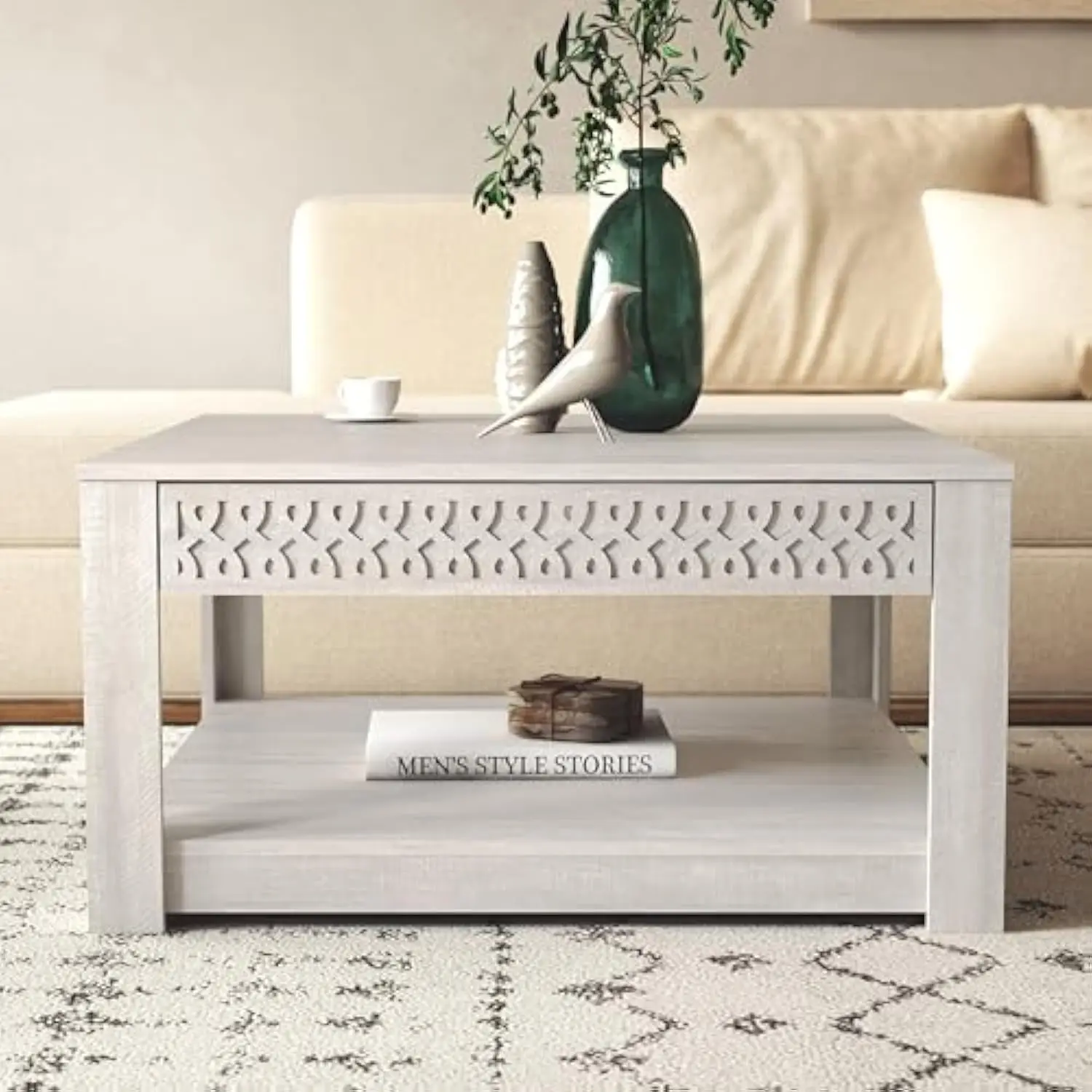
Conclusion: Bringing Timeless Elegance Home
The enduring appeal of marble coffee tables lies in their remarkable ability to combine natural beauty, design versatility, and timeless elegance into functional centerpieces for our living spaces. Their unique veining patterns tell geological stories millions of years in the making, while their cool, smooth surfaces invite both admiration and everyday use.
What makes marble particularly special is its chameleon-like ability to enhance virtually any design aesthetic. From sleek minimalist arrangements to warm mid-century modern settings, from traditional formal living rooms to eclectic bohemian spaces – a thoughtfully selected marble coffee table elevates the entire environment. This adaptability ensures that investing in quality marble furniture transcends passing trends.
As we’ve explored, the details matter significantly – the specific marble variety, finish treatment, table proportions, and base design all contribute to the overall aesthetic impact. Taking time to consider these elements ensures your marble piece will serve as both a practical surface and an artistic focal point that expresses your personal style.
Perhaps most valuably, a well-chosen marble coffee table brings a sense of natural luxury to everyday moments. Morning coffee, evening gatherings with friends, or quiet moments with a book all become subtly enhanced experiences when centered around a beautiful natural material that connects us to both geological history and design heritage.
For those ready to explore specific options for their spaces, our collection of mid-century modern square coffee tables offers distinctive pieces that balance timeless marble with elegant mid-century design principles.



